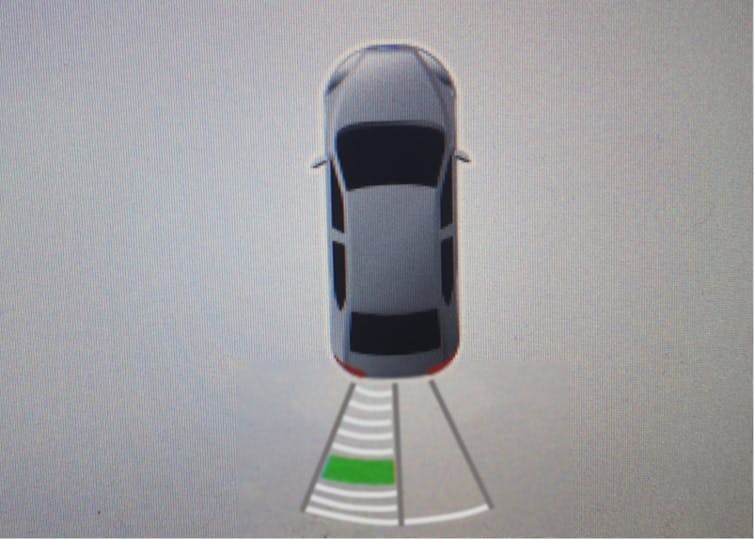
Nature has, over millions of years, evolved solutions to adapt to an array of challenges. As the challenges facing humanity become more complex, we are seeing inspiration being increasingly drawn from nature.
Taking biological processes and applying them to technological and design problems is called bioinspiration. This is a fast-growing field, and our ability to copy nature is becoming more sophisticated. Here are five striking examples where nature has guided human innovation – and in some cases, could lead to even more exciting breakthroughs.
1. Navigation
Using echolocation, bats are able to fly in complete darkness. They emit sound and ultrasound waves, then monitor the time and magnitude of these waves’ reflections to create three-dimensional spatial maps of their surroundings.
The sensors that identify obstacles when reversing in many modern cars are inspired by bat navigation. The direction and distance of an obstacle is calculated by emitting ultrasound waves which reflect off objects in a car’s path.

Sensory navigation technologies have also been proposed to improve the safety of those with restricted vision. Ultrasound sensors installed on the human body would offer sound-based feedback of a person’s surroundings. This would allow them to move more freely by eliminating the threat of obstacles.
2. Construction equipment
Woodpeckers knock on the hard surface of trees to forage for food, build nests and attract a mate. Construction tools, such as handheld hydraulic and pneumatic hammers, mimic the vibrating bill of a woodpecker using a frequency roughly equivalent to a woodpecker’s hammering (20 to 25 Hz).

But the vibration of these power tools can damage the hands of construction workers. This can, in some cases, cause vibration white finger, a condition where sufferers experience permanent numbness and pain in their hands and arms.
Research is now studying how woodpeckers protect their brains from the impact of repeated drilling. One study found that woodpeckers have several impact-absorbing adaptions that other birds do not have.
Their skull is adapted to be tough and hard, and their tongue wraps around the back of the skull and anchors between their eyes. This protects a woodpecker’s brain by softening the impact of the hammering and its vibrations.
Research such as this is guiding the design of shock absorbers and vibration control devices to protect the users of such equipment. The same concept has also inspired innovations such as layered shock-absorbing structures for building design.
3. Building design
Scallops are molluscs with a fan-shaped, corrugated external shell. The zig-zag shape of these corrugations strengthens the shell’s structure, enabling it to withstand high pressure under water.
The same process is used to increase the strength of a cardboard box, with corrugated paper material being glued between the two external cardboard layers. The introduction of a corrugated surface significantly increases a material’s strength, in the same way that folding a piece of paper into a zig-zag shape allows it to take an additional load.

The dome-shaped structure of a scallop’s shell also enables it to withstand significant loads. This structure is self-supporting as it distributes the weight evenly over the entire dome shape, reducing the load on a single point. This improves the structure’s stability without the need for reinforcing steel beams and has inspired the design of many buildings, including St Paul’s Cathedral in London.
4. Transport aerodynamics
Sharks have two dorsal fins which provide several aerodynamic advantages. They stabilise the shark from rolling, while their aerofoil shape creates an area of low turbulence behind them and so increases the efficiency of the shark’s forward movement.
Shark fins have been replicated in motorised transportation. For example, racing cars use fins to both reduce turbulence when travelling at high speed and improve stability when cornering.
Many road cars now have a small “shark fin” installed on their roof, which is used to integrate their radio antenna. This reduces drag compared to the traditional pole antenna.

We have also taken inspiration from nature to increase the efficiency of aircraft flight. An owl’s wings act as a suspension system; by changing the position, shape and angle of their wings, they are able to reduce the effect of turbulence while in flight. And research into owl flight may open the door to turbulence-free air travel in the future.
5. Velcro
The hook-and-loop fastening mechanism of velcro was inspired by the ability of the burrs of burdock plants to fasten to human clothing.
Plants use burrs to attach seed pods to passing animals and people, in order to disperse seeds over wider areas. Burrs possess small hooks that interlock with the small loops in soft material.
Velcro replicates this by using a strip lined with hooks together with a fabric strip. When pressed together, the hooks attach to the loops and fasten to one another.

Velcro is used in a wide range of products worldwide. According to Nasa, it was used in space during the Apollo missions from 1961 to 1972 to fix equipment in place in zero gravity.
Amin Al-Habaibeh does not work for, consult, own shares in or receive funding from any company or organisation that would benefit from this article, and has disclosed no relevant affiliations beyond their academic appointment.
This article was originally published on The Conversation. Read the original article.







